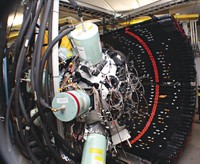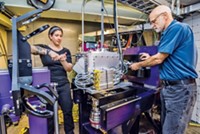Advertisement
Grab your lab coat. Let's get started
Welcome!
Welcome!
Create an account below to get 6 C&EN articles per month, receive newsletters and more - all free.
It seems this is your first time logging in online. Please enter the following information to continue.
As an ACS member you automatically get access to this site. All we need is few more details to create your reading experience.
Not you? Sign in with a different account.
Not you? Sign in with a different account.
ERROR 1
ERROR 1
ERROR 2
ERROR 2
ERROR 2
ERROR 2
ERROR 2
Password and Confirm password must match.
If you have an ACS member number, please enter it here so we can link this account to your membership. (optional)
ERROR 2
ACS values your privacy. By submitting your information, you are gaining access to C&EN and subscribing to our weekly newsletter. We use the information you provide to make your reading experience better, and we will never sell your data to third party members.
Physical Chemistry
New Neutron-Rich Isotopes Discovered
Magnesium and aluminum isotopes push the limits of nuclear stability
by Jyllian Kemsley
November 5, 2007
| A version of this story appeared in
Volume 85, Issue 45

CARBON-12 AND -14. Oxygen-16 and -18. Phosphorus-31 and -32. Add one or two neutrons to an element, and it creates another isotope.
But what about adding 14 or more neutrons to a light atom? That brings it to the "neutron drip line," the limiting number of neutrons that can be bound within an atomic nucleus. Such neutron-rich isotopes have fleeting lifetimes but nonetheless may play a critical role in stellar nuclear reactions. Understanding their properties could help deepen scientists' understanding of the atomic nucleus.
Researchers at the National Superconducting Cyclotron Laboratory (NSCL) at Michigan State University have now expanded the neutron drip lines of magnesium and aluminum by adding two neutron-rich isotopes, 40Mg and 42Al, to the list of those previously observed (Nature 2007, 449, 1022).
Led by Thomas Baumann, a physicist at NSCL, the researchers did the experiments by accelerating a beam of 48Ca atoms and shooting it at a tungsten target. When the calcium atoms hit the target, they fragmented, losing protons and neutrons to become various isotopes of other atoms, including the two newly observed ones. The researchers then separated the collision products magnetically and identified them with a tandem mass spectrometer.
The newly identified isotopes come on the heels of the discovery of 44Si earlier this year from the same group at NSCL, led by physicist Oleg B. Tarasov (Phys. Rev. C 2007, 75, 064613). Prior to 44Si, the last neutron-rich isotopes discovered were 34Ne, 37Na, and 43Si in 2002 (Phys. Lett. B 2002, 542, 49) and 31F in 1999 (Phys. Lett. B 1999, 448, 180).
That 40Mg could exist had been predicted by theoretical analysis. 42Al, however, was a surprise. Protons and neutrons reside in orbitals analogous to electron orbitals, and they also pair up like electrons. With 29 neutrons, 42Al has an odd, unpaired neutron, and for isotopes at the edge of the drip line, researchers thought such a lone neutron couldn't be bound. Notably, 30F, 33Ne, and 36Na, all with odd numbers of neutrons, have not been observed experimentally, although 31F, 34Ne, and 37Na, with even numbers, have been documented.
The researchers also observed one instance of 43Al, compared with three of 40Mg and 23 of 42Al. A single, unreproduced observation of an isotope is normally not a reportable result, but the fact that 42Al was documented makes the existence of 43Al credible. With an even number of neutrons, 43Al should be more stable than 42Al.
"This discovery that 40Mg and 42Al are stable is a major advance in our understanding of the limits of nuclear binding," says Richard F. Casten, a professor of physics and director of the A. W. Wright Nuclear Structure Laboratory at Yale University. Casten notes that the full impact of the newly identified isotopes is not yet understood. For example, scientists don't know whether the ability to pack in more neutrons than expected is limited to a small range of elements, including magnesium and aluminum, or whether it's a characteristic that eventually will be observed across the entire periodic table.
NEVERTHELESS, the observation of 42Al, with its unpaired neutron, "alters the landscape of known nuclei," Casten says. "It alters our understanding of the forces that bind nuclei into stable objects, and it has important implications for future attempts to map the evolution of nuclear structure and existence into the most weakly bound nuclei."
The latest NSCL experiment stretches the limits of current particle accelerators, according to Paul-Henri Heenen, a professor of nuclear physics at Université Libre, in Brussels, who wrote a commentary on the work. Further experimental input on the location of the neutron drip line may require new accelerators, such as a facility for rare-isotope beams, identified as a priority for the long-range plan for nuclear science being developed by the Department of Energy and the National Science Foundation. In the meantime, Heenen says, NSCL's results will likely be used to improve the accuracy of current theoretical models of nuclear interactions.




Join the conversation
Contact the reporter
Submit a Letter to the Editor for publication
Engage with us on Twitter